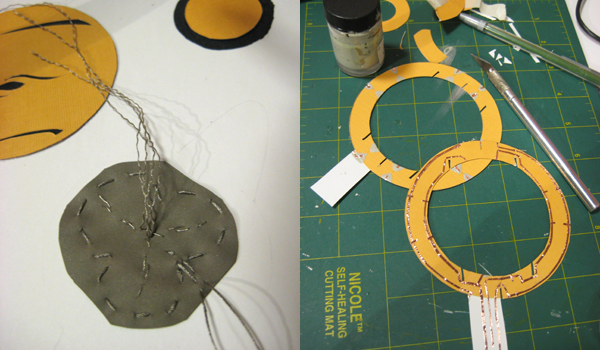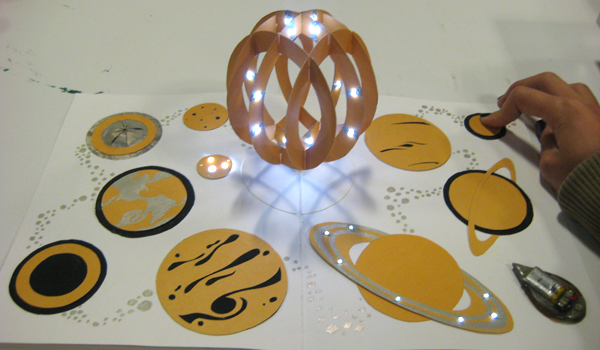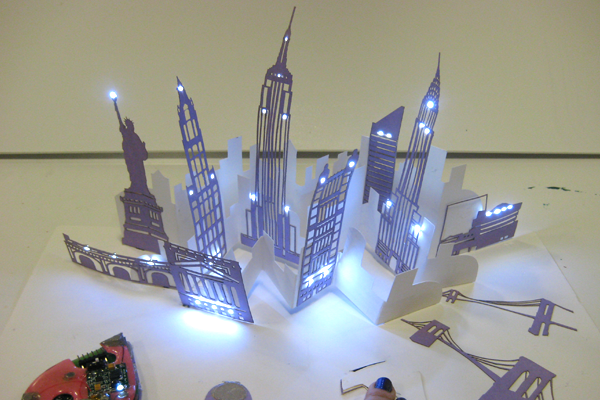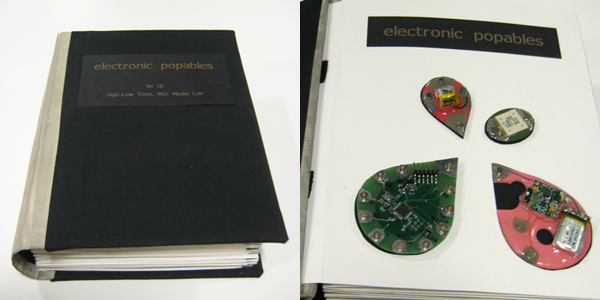|
|
home | project | blog | media |
|
week | 1-2 | 3-4 | 5-6 | 7-8 | 9-10 | 11 | week nineMonday 7/20: yellow page With only two weeks remaining in my internship, I've been pulling extra hours to get this book finished. I still have two pages remaining one for pressure sensors and one for bend sensors. For the pressure sensor page, Iíve decided to go with yellow color and a solar system theme. The main pop-up will be a sphere sliceform which will represent the sun. A sliceform is a series of paper rings that are crisscrossed to form a sphere. The planets will become pressure sensing ďpushbuttonsĒ as well as actuators I came in over the weekend to complete some of the mechanical portions of the page. Iíve gotten the sun to pop up and collapse. Though the sliceform pop-up appears very complex, it is actually very easy to wire since there are only two folds on the entire structure (the base which connects to the page). I finished making cutouts of all the planets, which was actually rather tricky since I had to make them all the same color!  Making the pressure sensor actually took some finessing. The actual sensing material is a rubbery substance that becomes conductive when squeezed or stretched. To make the sensor I simply sew two conductive threads through the rubber with little spacing in between. When the user pushes on the rubber between the threads, the rubber becomes conductive and so the threads become electrically connected. The problem with this technique is that if the rubber becomes stretched in the process of sewing, the two threads are permanently connected. After the sensor is made, I sew it into the page, then cover it with a piece of insulating fabric, and finally glue the cutout of the planet over the fabric to distribute the pressure Tuesday 7/21: yellow page complete! I finished the circuitry to the yellow page. When Pluto is pushed, a group of LEDs on the sun light up. When Uranus is pushed, Saturnís rings light up. When the earth is pressed, the moon becomes dim. Finally, when Mars is pressed, Venus begins to vibrate.  Thursday 7/23 Ė Friday 7/24: purple page After a brief block, I finally decided on a theme for the bend sensing (and last!) last page. It will be purple and use the New York City skyline. The more the sensor is bent, the more lights on the buildings will light up. To build the skyline, I chose some of the most distinctive structures in New York, drew a vector version of these buildings using images found online, and finally used a laser cutter to cut the vectors out. I made sure to keep much of the distinctive window patterns so that most of the skyscrapers have so may windows they look like lace! Iím very excited about the circuitry that will go into these buildings. The lights will be literally hanging in the holes that make up the windows. To make the traces I will simply paint the backs of the buildings. Since a paint stroke can be is only as thin as the paper itís painted on, I can fit the circuitry onto such a limited space. Some of the strips of paper are only about one millimeter wide. This would be virtually impossible with wires or even copper tape. I first experimented with the Statue of Liberty piece and Iím pleased to say itís a success!  week tenMonday 7/27 - Tuesday 7/28: purple page completed! After some major weekend hours and late nights spent in the lab, I've gotten the purple page completed and working! The bend sensor is hidden in a flap that is shaped like a sailboat. When the user lifts the flap, which normally lays flat against the page, the bend sensor is bent. This causes four levels of lights to light up sequentially. Along with the lights, a speaker makes a tone that rises as the sailboat is lifted.  Wednesday 7/28 - Friday 7/30: book binding Now that all the pages are completed, I've spent the past few days working on putting the pages together into a book. I've decided to title is "Electronic Popables" (given more time, I probably coul dhave come up with a wittier title... but this will work for now!). One of the main issues is that the pages must be insulated from each other. Also, it needs to be read like a regular pop-up book, so that the pages with circuitry are skipped. However, the circuitry must also be accessible for educational and (more importantly!) debugging purposes. Finally, the book must have a place to store the magnetic components (arduino, batteries, speaker).  I chose to connect all the pages using an accordion structure and stuck a blank page between each of the pop-up pages. The blank page also serves as a place to put a label introducing the type of circuit element (e.g. "bend sensor") on the next page. I used Velcro to keep the backs of the pages, so that they can be opened up but do not pop out from the book cover during normal reading. The hardcover, which I've heard "looks like a Harry Potter book," is actually a slip cover so that the pages can be removed from the cover entirely.  Overall I'm extremely happy with how the book came out. My only concern is that some of the circuitry has changed in the process of putting the pages together. So, even though I'm flying back to Florida on Monday, I have to come back into lab to do some last minute debugging! |